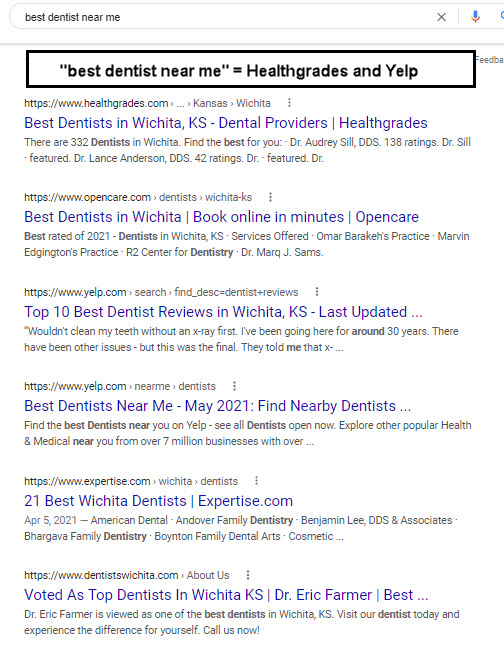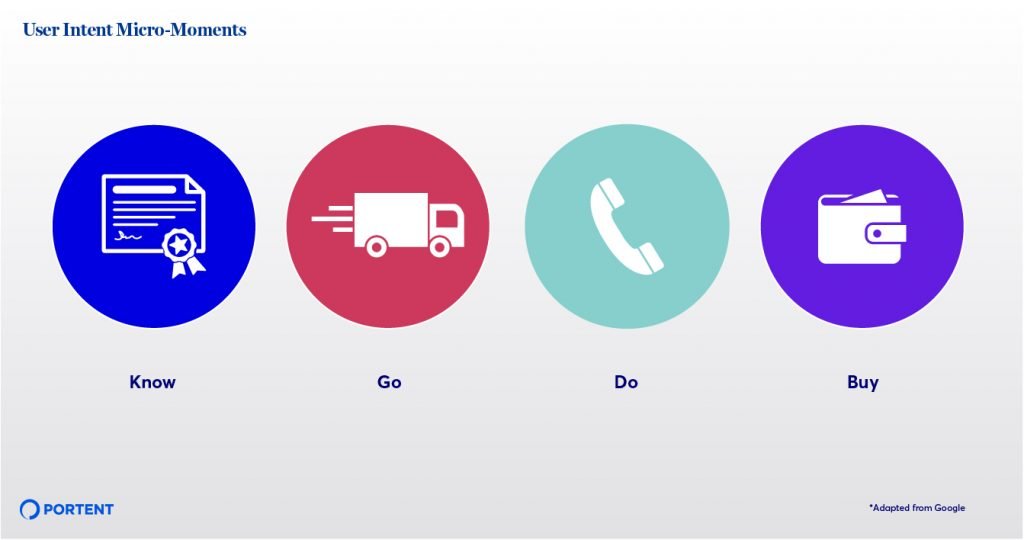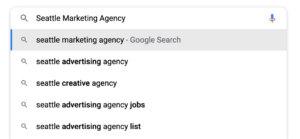Previously, I wrote about the local search microcosm and how it’s a crucial factor for any local SEO campaign. By deriving context from the local search microcosm, marketers and business owners alike can prioritize the pieces of local SEO that matter most.
While the concept of the local search microcosm focuses primarily around search engines, the Internet, location, and services, there’s one piece of the puzzle we haven’t yet discussed—users.
A local website isn’t made for the business owner or the marketer or the web developer. It’s made for the user; the guy who needs a decent taco; the stressed-out building owner with a broken pipe; the mom who wants to make sure her child’s doctor is trustworthy; anyone who might be searching on Google for what they need.
Users matter. This post discusses the various states of intent behind an online search for local businesses, with specific caveats around what’s useful to consider as a marketer.
What Users Want
When you fire up the ol’ keyword research process, where do you start? In my earlier days, I was content to type “plumber” into a fancy SEO tool and receive a list of similar terms and search volumes. BUT—I was wrong! Local keyword research doesn’t start with a sprawling list of 2,000 random words. It starts with an assessment of how the website helps people. By establishing the core intent of the website, we can refine our keywords accordingly.
User intent comes from the fundamental understanding that people are looking for stuff. After all, that’s why you’re in marketing and it’s why you’re reading this post. Everyone has a reason why they need or want something—as a marketer, you should figure out what that reason is.
While several styles of categorization have been defined for user intent, for local SEO I recommend consideration of Google’s metrics defined in 2016 as “micro-moments” on mobile search:
The “Know,” “Go,” “Do,” and “Buy” categories of user intent can generally align with the different sections of a website:
- “Know” is usually website blog content, or a Yelp listing
- “Go” is the Google My Business profile
- “Do” is a service page or a location page on the website
- “Buy” is a CTA on the website or eCommerce functionality
Of course, these micro-moments extend far beyond general associations with parts of a website. They can also come with some challenges unique to the local keyword research and the local search microcosm. Rather than expound ceaselessly on the multitude of micro-oments, I’ll cover a few specific details of what not to do when looking at user intent.
Here’s how each type of user intent can be applied to local SEO:
Know (AKA Stay Away From “Best”)
We see “know” less frequently at the local SERP level—people looking for services nearby will typically hold some general understanding of what they need. However, people often search locally for “the best” lawyer/restaurant/HVAC contractor near them.
If you’re trying to use keyword research to get your website to rank for “best,” I wish you luck. Not a lot of on-page SEO magic can go into helping a local client rank for “best,” unless that recognition was earned outside of the website. In fact, “best” is a keyword ranking typically reserved in the SERP for citation websites (type “best dentist near me” as an example).

When we dig deep and truly explore the local user intent behind “best,” as a query, what does a user really want? Do they want a pediatrician who claims he is the “best” with no real proof on the webpage (and just two reviews on his Google My Business profile)? Or, do we want a list from healthgrades.com with a clear and trustworthy vetting process?
Now that we understand what users want from a “best” ranking, we can refine our local SEO strategy accordingly. While a local website can’t show up in the SERP, a local business can get recognized with a high-value backlink from Yelp, Healthgrades, FindLaw, or a local news publication. This is the part where PR and off-page SEO become important to a Local SEO strategy.
When completing local keyword research, it’s worth explaining to a stakeholder that “best” rankings can happen, just not directly on their website. With the right resources and quality day-to-day operations, a local business can benefit greatly from recognition in local media outlets and beyond.
Go (The “Near Me” Search)
When people want to “Go,” they’re typically looking to engage with a location nearby. Enter the “near me” search; a ranking of common pursuit in the local SEO arena. Google regularly publishes data to indicate large year-over-year increases in “near me” searches.
The continued increase in “near me” searches also means that it’s valuable to rank for them. But this is easier said than done.
When people type “near me,” what do they really want? They want something almost completely out of the marketer’s control—proximity. Location is part of the local search microcosm (how and why Google chooses your site), but it’s also a factor considered by users. Beyond setting up shop at an address in the center of town and verifying a Google My Business profile at that location, the business cannot “SEO” their “near me” rankings.
However, all hope is not lost with a far-flung location on GMB. A strong understanding of user intent can guide search engines and users toward a local website. When trying to rank for “near me” keywords, the focus should be less about the use of “near me” in the content and more about the specific keyword next to it.
“Near me” rankings only happen for high-demand, often urgent user queries. They will only happen if the marketer and the stakeholder align on what to target because they understand what users want.
Let’s consider an HVAC contractor who at first only wants to rank organically for “AC installation” or “AC replacement” keywords, because these services make more profit than AC repair. In these situations, it’s important to remember the larger sales cycle behind the user intent.
Users might not type “AC replacement,” because they don’t understand the service they actually need. A user is more likely to search “AC repair near me,” because they don’t realize their unit is beyond repair, leading them in a roundabout way to the more profitable services. The best local keyword research considers the genuine value of user intent behind a “go” keyword, rather than its perceived value. If a website knows its users, it can probably rank for those high-demand “near me” searches.
Do (Or “How To” Not Do Local SEO)
I provided a sassy parenthetical to this type of user intent because at the local level, users can either choose to DIY or hire someone locally. I’m only going to talk about DIY here because, well, as a marketer you probably are aware of people wanting to buy things.
“How to” searches are typically associated with national search results. If I am a dad Googling “how to tile the shower,” I’m unlikely to pick up the phone and call my local contractor (probably to my wife’s chagrin). After all, I’m in dad mode. This makes a ranking for “how to tile the shower” relatively useless for organic lead generation.
As a trickle-down effect, nationally-ranked blog content can lead to some stellar local rankings. When Google trusts a website as a whole and rewards it with national rankings for “how to lay concrete,” that website may have established the necessary trust to also rank for “concrete leveling service Portland.” But—this strategy is typically putting the cart before the horse in local SEO. Rather than focus on keywords that give away information and won’t result in a call, it’s probably better to start with the phrases that result in qualified leads (sorry, dads).
Buy (“Deliver” The Best Services)
This type of local user intent became big at the onset of the pandemic. Users pivoted from casually shopping around town to frantically discovering nearby resources for delivery or pick-up. This is a space where it’s up to the business to innovate its digital or remote offerings, and up to the local search marketer to ensure effective communication of those offerings.
The crucial piece of user intent here is making it easy for users to connect with you directly. While it’s not a direct ranking factor with search engines, I’ll always check to see if a local website’s mobile version has click-to-call functionality enabled in its most prominent spaces.
A basic understanding of conversion rate optimization can go a long way to improve engagement across a website, and rankings as a result.
Be Purposeful
Ultimately, user intent drives local keyword research because it allows the marketer to hone in on the phrases that will make the biggest impact. By defining keyword terms that will truly drive conversions, rather than muddle our marketing message, we refine our goals. When we understand our objectives, it’s that much easier to achieve them.
This larger series of posts on How to Do Local SEO is focused on finding the right keywords for a local campaign. In my next post, I’ll cover how marketers can leverage local search volume data (in the context of user intent and the local search microcosm) to achieve those local rankings and help those moms find that pediatrician.
The post How to Do Local SEO, Part Two: User Intent appeared first on Portent.




